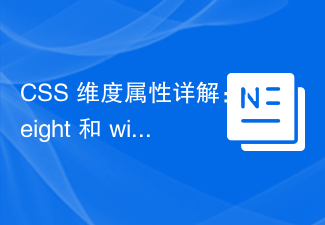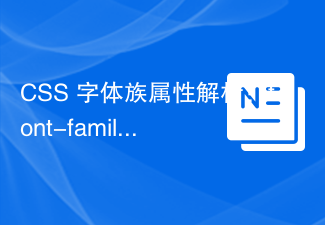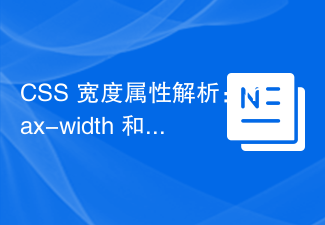Found a total of 10000 related content

CSS measurement properties parsed: height, width and max-height/max-width
Article Introduction:Analysis of CSS measurement properties: height, width and max-height/max-width, specific code examples are required. In CSS, there is a set of measurement properties used to control the height and width of elements, including height, width and max-height/max-width. . These properties are very useful when designing and laying out web pages and can help us adjust the dimensions and size of elements accurately. height attribute: The height attribute is used to set the height of an element.
2023-10-21
comment 0
2057

CSS measurement properties: height, width and max-height/max-width
Article Introduction:CSS measurement properties: height, width and max-height/max-width, specific code examples required In web design and development, controlling the size of elements is very important. By using the CSS measurement properties, we can precisely define the height and width of an element, as well as the maximum limit of the element's size. This article will introduce the commonly used measurement properties in CSS: height, width, max-height and max-width, and provide specific code examples.
2023-10-20
comment 0
1071

Detailed explanation of CSS dimension properties: height and width
Article Introduction:Detailed explanation of CSS dimension properties: height and width In front-end development, CSS is a powerful style definition language. Among them, height and width are the two most basic dimension attributes, used to define the height and width of the element. This article will analyze these two properties in detail and provide specific code examples. 1. Height attribute The height attribute is used to define the height of an element. You can use pixel, percentage or
2023-10-21
comment 0
1624

CSS overlapping property analysis: position and float
Article Introduction:Analysis of CSS overlapping attributes: position and float In CSS, position and float are two commonly used overlapping attributes. They can change the layout behavior of elements and achieve various complex page effects. This article will analyze these two properties in detail and give specific code examples. 1. Position attribute The position attribute defines the positioning method of the element. Commonly used values are static, relative, absolute and fixed.
2023-10-20
comment 0
1097

Analysis of CSS relative positioning properties: relative and z-index
Article Introduction:Analysis of CSS relative positioning attributes: relative and z-index, specific code examples are required Introduction: In web design, we sometimes need to adjust the position and display level of elements. CSS relative positioning properties can help us achieve these effects. This article will analyze the relative attribute and z-index attribute in CSS relative positioning attributes in detail, and provide specific code examples. 1. The role and usage of the relative attribute relative in CSS
2023-10-21
comment 0
1528

CSS cascading property analysis: z-index and position
Article Introduction:Analysis of CSS cascading properties: z-index and position In CSS, z-index and position are two commonly used cascading properties, which are used to control the stacking order and positioning of elements. This article will analyze these two properties in detail and provide relevant code examples. 1. z-index attribute The z-index attribute is used to control the stacking order of elements. It accepts an integer value as a parameter. The larger the value, the higher the element is displayed. By default, the z-index value of an element is 0.
2023-10-20
comment 0
1508

Analysis of CSS absolute positioning properties: absolute and fixed
Article Introduction:CSS absolute positioning attribute analysis: absolute and fixed Absolute positioning is a common and useful layout technique in CSS. By using the position:absolute or position:fixed attribute, an element can be detached from the normal document flow and positioned relative to its containing element. To position. This article will analyze the two absolute positioning properties of absolute and fixed in detail and provide specific code examples. position:absolute
2023-10-24
comment 0
1407

CSS visual property analysis: box-shadow, text-shadow and filter
Article Introduction:Analysis of CSS visual properties: box-shadow, text-shadow and filter Introduction: In web design and development, CSS can be used to add various visual effects to elements. This article will focus on the three important properties of box-shadow, text-shadow and filter in CSS, including their usage and effect display. Below we analyze these three properties in detail. 1. box-shadow (box shadow) box-shado
2023-10-20
comment 0
1329

CSS drop-down menu property analysis: position and z-index
Article Introduction:Analysis of CSS drop-down menu properties: position and z-index In web design, drop-down menu is a common component used to display more options or hide some content. In order to implement a complete drop-down menu, it is very important to master the position and z-index properties. This article will analyze these two properties in detail and provide specific code examples. 1. Position attribute Position is an important attribute in CSS, used to define the position of an element.
2023-10-20
comment 0
1081

CSS floating property analysis: float and clear
Article Introduction:CSS floating attribute analysis: float and clear The floating attribute (float) and clear attribute (clear) in CSS (CascadingStyleSheets) play an important role in designing web page layout. They allow elements to float within the page and are useful for creating multi-column layouts and responsive designs. In this article, we will explain the float and clear properties in detail and provide specific code examples. 1. float attribute float attribute is used
2023-10-21
comment 0
1013

CSS auxiliary style attribute parsing: cursor and pointer-events
Article Introduction:CSS auxiliary style attribute analysis: cursor and pointer-events In website development, we often encounter some special needs, which need to be achieved through some auxiliary style attributes. Cursor and pointer-events are two commonly used style attributes that provide better feedback and control when users interact with the page. This article will analyze these two properties in detail and provide specific code examples. 1. Cursor attribute The cursor attribute is used to define the mouse
2023-10-20
comment 0
1568

Analysis of CSS positioning properties: position and top/left/right/bottom
Article Introduction:CSS positioning attribute analysis: position and top/left/right/bottom CSS (cascading style sheet) is a language used to describe web page styles. It contains a rich set of attributes and selectors. In CSS, positioning properties are widely used to control the position of elements on the page. Among them, the combination of position attribute and top/left/right/bottom attribute can achieve precise element positioning effect. position attributepositi
2023-10-24
comment 0
1473

Analysis of CSS text shadow properties: text-shadow and box-shadow
Article Introduction:Analysis of CSS text shadow properties: text-shadow and box-shadow In web design, in order to enhance text effects and present richer visual effects, CSS provides some properties to set text shadows. Two common text shadow properties are text-shadow and box-shadow. By using these two attributes properly, we can easily achieve a variety of cool text effects. text-shadow property text-shadow property
2023-10-20
comment 0
1930

CSS hyperlink attribute analysis: text-decoration and color
Article Introduction:CSS hyperlink attribute analysis: text-decoration and color hyperlinks are one of the commonly used elements in web pages, which can establish connections between different pages. In order to make hyperlinks clearly identifiable and attractive on the page, CSS provides some properties to adjust the style of hyperlinks. This article will focus on text-decoration and color, two CSS properties related to hyperlinks, and provide you with specific code examples. text-decor
2023-10-20
comment 0
1243

CSS font family property analysis: font-family and font-size
Article Introduction:Analysis of CSS font family attributes: font-family and font-size In web design, the selection and size of fonts are very important. They directly affect the readability and overall style of the web page. CSS provides a wealth of font properties, the most commonly used of which include font-family and font-size. The font-family attribute font-family is used to specify the name of the font or the priority order of the font family. For example, we can use something like
2023-10-21
comment 0
1048

Analysis of CSS multi-column layout properties: column-count and column-gap
Article Introduction:Analysis of CSS multi-column layout attributes: column-count and column-gap, specific code examples are required. In web design and development, multi-column layout is one of the common and useful layout methods. CSS provides some properties to implement multi-column layout, the most commonly used ones are column-count and column-gap. The column-count attribute is used to set the number of columns of an element, while the column-gap attribute is used to set the gap between elements.
2023-10-20
comment 0
1612

CSS width attribute analysis: max-width and min-width
Article Introduction:CSS width attribute analysis: max-width and min-width, specific code examples are required Introduction: In web design, controlling the width of elements is very important. CSS provides a variety of ways to set the width of elements, of which max-width and min-width are two commonly used properties. By controlling the maximum and minimum width of elements, we can achieve adaptive and responsive layout effects. This article will introduce the usage of max-width and min-width in detail and give specific
2023-10-27
comment 0
1506

















